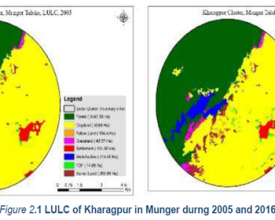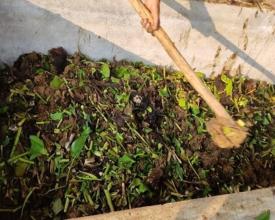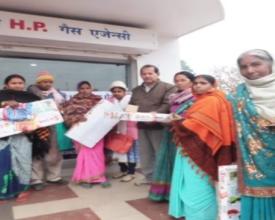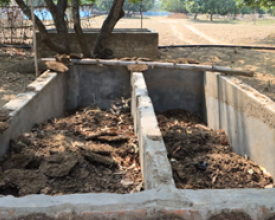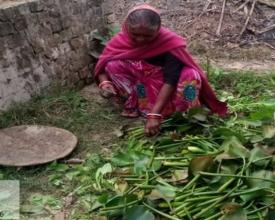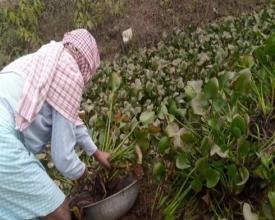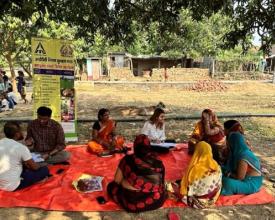
From Fields to Forests: Integrating Nature into India Kharagpur’s Agriscapes
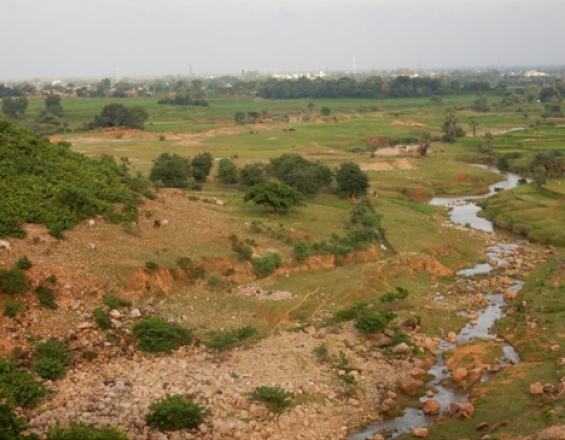
The Sustainable Agriscapes for Future (SAF) project, led by IUCN and ITC, addresses ecosystem degradation in the Kharagpur Agriscape of Bihar, India through nature-based solutions. The Agriscape, reliant on forests and a lake, faces challenges such as deforestation, soil erosion, spread of invasive species, and unsustainable farming practices. Through spatial planning, the project delineated the Kharagpur Agriscape and developed Kharagpur Agriscape Plan aimed at conserving and enhancing natural ecosystems vital for supporting agriculture within the cluster. This included interventions such as women-led eco-nurseries, vermicomposting using using invasive water hyacinth, and community pastureland for fodder. These nature-based, community-centered solutions enhance soil health, reduce pressure on forests, and empower women and farmers. Capacity-building, alternative livelihoods, and improved ecosystem services underpin this replicable approach for sustainable rural development.
Context
Challenges addressed
The Kharagpur landscape faces ecosystem degradation, driven by overdependence on fuelwood and fodder leading to forest degradation, increased soil erosion, and siltation of its lake. Social challenges include lack of awareness about sustainable agricultural practices and low technical capacity among tribal farmers. Economically, most households are below the poverty line and landless. Unsustainable agriculture practices have depleted soil fertility. Lack of community awareness regarding invasive species and lack of alternative livelihoods further threatens the ecosystem.
Location
Process
Summary of the process
The solution combined ecological restoration with inclusive, community-led action. Vermicomposting transformed biomass from invasive Water Hyacinth into productive input; fodder cultivation reduced stress on forests while improving livestock systems; and women-led nurseries contributed to improved incomes. These building blocks were designed based on local assessments and implemented in coordination with community members. Their interaction ensured ecological restoration while uplifting vulnerable groups, especially women and landless farmers.
Building Blocks
Community-led vermicomposting using water hyacinth
To address the dual challenges of wetland degradation and declining soil fertility, the project introduced vermicomposting of invasive water hyacinth. This fast-growing aquatic plant was manually removed by community members and processed in vermicompost pits provided through the project. The biomass was converted into nutrient-rich organic fertilizer, restoring soil productivity. In Banbarsa village, farmers successfully used this vermicompost to grow okra, brinjal, bottle gourd, and ridge gourd—without applying any chemical pesticides or fertilizers. These efforts not only improved crop yields but also enabled women farmers like Ruby Devi to share surplus harvests with others in the village, promoting food security and social cohesion. The initiative demonstrated how invasive species management could be transformed into a livelihood-enhancing, ecosystem-restoring practice. Moreover, vermicomposting helped rehabilitate wetland ecosystems by curbing hyacinth spread, allowing sunlight and oxygen back into aquatic systems, thereby restoring its biodiversity.
Enabling factors
• Community training on vermicomposting techniques ensured adoption of best practices.
• Provision of vermicompost pits, tools, and follow-up technical support enhanced implementation.
• Success stories from pilot participants created motivation and trust in the process.
• Peer-to-peer learning, especially among women, fostered rapid knowledge exchange.
Lesson learned
• Vermicomposting invasive biomass supports both ecological restoration and sustainable agriculture.
• Women’s leadership in vermicomposting generated community-wide interest and strengthened social bonds.
• Behavior change requires sustained awareness-building and visibility of results.
• Limited mechanized options for removal of water hyacinth created bottlenecks, suggesting need for technical upgrades.
• Active local facilitators were essential to motivate participation, address challenges, and scale the practice to new areas.
Individual fodder cultivation for sustainable livestock management
To reduce pressure on nearby forests, certain individual farmers were supported to cultivate green fodder (oats and maize) on private plots. This intervention aimed to transition livestock feeding away from forest foraging to stall-feeding using cultivated fodder. Households adopted varieties like oats that yield multiple harvests annually, improving economic returns and ensuring a reliable feed source. Women like Vasanti Devi found health improvements in livestock health and reduced vet expenses after switching to green fodder, reinforcing adoption. The total fodder yield reached over 49,000 kg, valued at over USD 843. Households saved up to USD 28 – USD 34 annually by reducing feed purchases and medicine costs. This practice also contributed to reduced forest degradation, improved milk yields, and created an entry point for sustainable livestock management practices within the agriscape.
Enabling factors
• Timely access to quality fodder seeds and technical training boosted adoption.
• Demonstration plots helped farmers visualize benefits before committing land.
• Strong linkage between green fodder use and improved cattle health motivated uptake.
• Methods were simple and suitable for small, leased, or marginal landholders.
Lesson learned
• Crops like oats, with multiple harvests per season, are more cost-effective than single-harvest crops.
• Farmers who adopted early became community champions and influencers.
• The approach is best suited to areas with small land parcels near homesteads.
• Additional extension support is needed for fodder preservation (e.g., silage).
• Inclusion of women enhanced the diffusion of knowledge and practice, especially in managing livestock health.
Women-led eco-nurseries for reforestation and livelihoods
Women groups in the Kharagpur agriscape established eco-nurseries to produce seedlings of multipurpose tree species (MPTS) such as Moringa (Moringa oleifera), Teak (Tectona grandis), Papaya (Carica papaya), and Mahogany (Swietenia macrophylla). These nurseries supported reforestation and provided additional household income. Manju Kumari and others used their land to raise seedlings, supported by custom hiring centers and training from Bhagalpur University. The nurseries produced high-quality planting stock for plantation drives and private land use. Sales from seedlings generated up to approximately USD 570/year per group. Women gained leadership experience by managing nursery operations and supported outreach to other farmers. The activity reduced fuelwood dependency while enhancing economic resilience and social recognition for women’s groups in the village.
Enabling factors
• Provision of land by local farmers enabled group-based nursery siting.
• Formal training from Bhagalpur University built technical capacity in seedling propagation.
• Financial and logistical support through ITC and custom hiring centers ensured smooth setup.
• Strong social cohesion and mutual trust within women’s groups strengthened performance.
Lesson learned
• Empowering women through nursery management created ownership, accountability, and long-term sustainability.
• Protection measures (e.g., fencing) were critical to prevent livestock from damaging seedlings.
• Reliable access to seed markets and offtake arrangements could further improve profitability.
• Flexibility in nursery operations allowed them to adapt to seasonal constraints and opportunities.
• Income generation acted as a strong incentive for quality maintenance and future expansion.
Impacts
Environmental impacts:
The project led to a significant reduction in pressure on local forests through reduced dependence on fuelwood and fodder collection. A total of 49,505 kg of fodder was produced locally (14,055 kg maize and 35,450 kg oats), reducing exploitation of natural resources. Additionally, the use of vermicompost improved soil health, contributing to more sustainable land management and supporting enhanced biodiversity in surrounding areas.
Social impacts:
Several women were trained in nursery management and vermicomposting, fostering local capacity and promoting women’s empowerment. The initiative also fostered strong community ownership, which has helped develop local leadership, particularly among women. Improved access to fodder and vermicompost has contributed to better household food security and milk yield, directly benefiting local well-being.
Economic impacts:
The locally produced fodder generated an estimated USD 846 in value, while the combined use of vermicompost and fodder led to household-level savings of approximately USD 34–USD 57 per family. These economic benefits have improved the livelihood resilience of participating households.
Beneficiaries
Smallholder farmers, tribal communities, landless households, women self-help groups, youth engaged in nursery work, and dairy farmers.
Global Biodiversity Framework (GBF)
Sustainable Development Goals
Story
Ruby Devi’s Vermicomposting Journey
Ruby Devi, a farmer in Banbarsa, turned water hyacinth (invasive species) into a resource, creating vermicompost that transformed her home garden. Producing abundant vegetables, she shared her surplus with other farmers in the village, building social bonds and inspiring others to try vermicomposting. Her initiative not only promoted natural farming but built a stronger, self-reliant community of women.
Vasanti Devi’s Fodder Breakthrough
Initially skeptical, Vasanti took up fodder cultivation and saw health improvements in her cows and savings in veterinary costs. Her example encouraged more women to try fodder farming, ensuring healthier livestock and less pressure on forests.
Manju Kumari’s Nursery Leadership
Manju, a 45-year-old farmer, transformed her 3-acre farm through crop diversification and modern techniques. Her leadership in the eco-nursery network and mentorship for other women has made her a role model for sustainable agriculture in the region.

